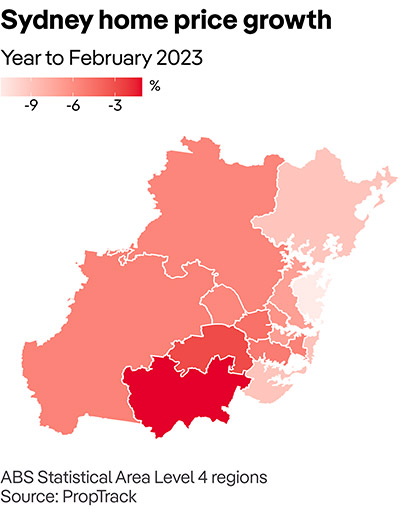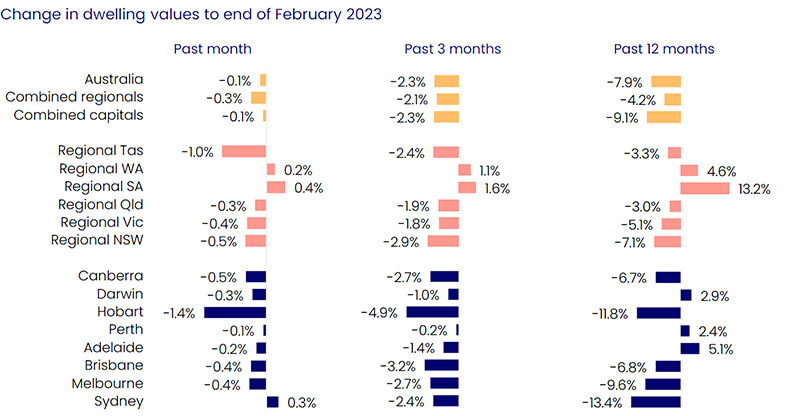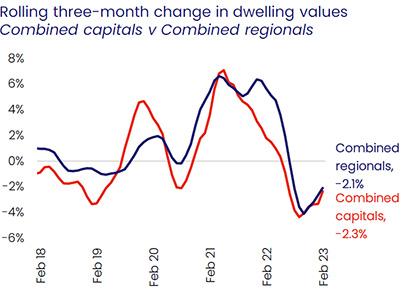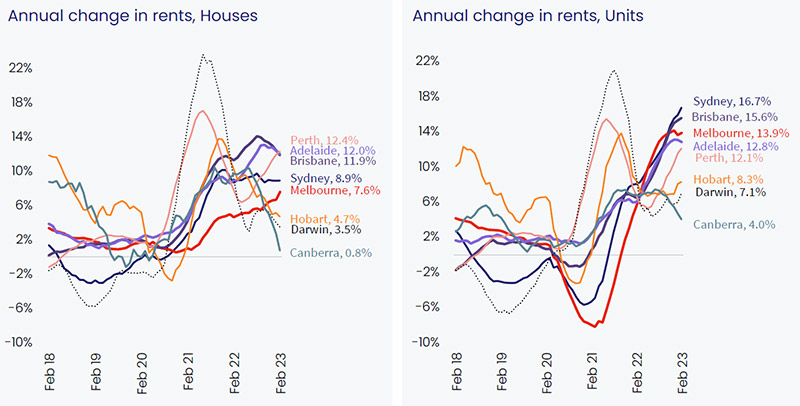Sydney on the up as national property price falls ease
While it is far too early to call an end to the property market's downturn, a resurgence in Sydney's real estate values and slower than usual price falls elsewhere have buoyed the market.
Sydney, the city that contributed much to the recent downturn in property prices nationally, is now leading what may amount to a recovery or simply be an aberration.
National property prices, according to CoreLogic’s Home Value Index (HVI), have recorded the smallest monthly fall since May 2022 (-0.13 per cent), when rate hikes commenced.
The national decline of 0.14 per cent was moderated by Sydney’s relatively surprising monthly rebound of 0.3 per cent in what is now an annual drop of 13.4 per cent.
Sydney’s priciest property markets had led the falls and they are now leading the gains. Sydney’s upper quartile recorded a 0.7 per cent rise in values over February, compared with a 0.2 per cent fall in values across the lower quartile of the Sydney market.
Upper quartile housing values have led the downturn to date, dropping 13.5 per cent in value across the combined capital cities over the past 12 months, compared with a 1.7 per cent rise in values across the lower quartile.

While all other capital cities recorded relatively small property price drops, the pace of decline slowed in every city except Darwin (-0.3 per cent). Only Hobart (-1.4 per cent) saw housing values fall by more than half a per cent over the month.
CoreLogic’s research director, Tim Lawless, said the stabilisation in housing values over the month coincides with consistently low advertised supply levels and a rise in auction clearance rates.
He stressed that property owners should refrain from popping the champagne corks just yet.
“Considering the Reserve Bank of Australia’s move to a more hawkish stance at the February board meeting, along with an expectation for a weaker economic performance and a loosening in labour markets, there is a good chance this reprieve in the housing downturn could be short-lived,” Mr Lawless said.
“We also have the fixed-rate cliff ahead of us; arguably the full impact of the aggressive rate hiking cycle is yet to play out.”
A separate home price index released by PropTrack concluded that property prices nationally had actually recorded a small increase, up by 0.18 per cent in February.
PropTrack Senior Economist Eleanor Creagh stressed it was too early to call an end to the downturn, arguing there were factors beyond interest rates at play.
“Sellers in the market now are benefitting from low competition with other vendors, as buyers vie for available stock.
“The constrained level of properties available for sale is putting a floor under home prices and has concentrated buyer demand.
“The longevity and depth of the current downturn will be influenced by the level of supply, as well as the trajectory of interest rates, in the months ahead.
“A further 25 basis point (0.25 per cent) rate rise in March, taking the cash rate to 3.60 per cent, is widely expected, which will weigh on borrowing capacities further, however, if supply remains limited, this will help counter the downward pressure on home prices.”
Interest rate rises appear to at last be doing their job.
New figures released Wednesday (1 March) show inflation slowed to 7.4 percent for January, down one percent from December. Economists had been predicting the January CPI would be 8.1 per cent.
The RBA will decide on Tuesday 7 March whether to inflict a tenth consecutive interest rate hike on borrowers. The inflation figure coupled with unemployment rising to 3.7 per cent in January may subdue their enthusiasm to impose another rate rise, while subdued GDP figures and a tepid rise in consumer spending also support the arguments of those calling for a reprieve from rate rises, even if only temporarily.

Source: CoreLogic Home Value Index - March 2023
Regions still attracting city dwellers
Regional dwelling values were down 0.3 per cent in February, according to CoreLogic, compared with a 0.1 per cent fall across the combined capital cities.
Addressing findings from his Hotspotting Exodus to Lifestyle report, Hotspotting Director Terry Ryder said Australians continue to leave the two biggest cities and head north or west.

Source: CoreLogic Home Value Index - March 2023
The latest population data showed Queensland is a huge beneficiary of population growth from internal migration, while Western Australia and South Australia have also made good gains.
He said families are heading to locations that offer lifestyle at prices that are affordable compared to Melbourne, Sydney, and Canberra, which have median prices ranging from $900,000 to $1,200,000, even after some recent price declines.
“The result for regional property markets has been extraordinary, leading to strong demand and price growth in many areas,” Mr Ryder said.
“Indeed, the regions overall have been outperforming the capital cities on price for the past five years, thanks to this compelling trend.
“And now, at a time when some markets are declining from the boom-time peak levels, the regional markets overall are showing the strongest resistance to the downturn trend, which is why we believe that the exodus to affordable lifestyles trend will continue.”
While regional prices were down more than capitals overall, the weaker regional result relative to the combined capitals was mostly a factor of the monthly rise in Sydney housing values rather than a larger fall in regional market values.
Each of the broad rest-of-state regions, apart from NSW, recorded a monthly outcome that was inline or stronger relative to their capital city counterparts.
Rental stress worsening
The soaring cost of housing is putting pressure on low to middle-income earning renters, especially in major cities such as Sydney and Melbourne.
Unit rents, most favoured by lower income earners, are surging. With vacancy rates remaining around record lows, it is likely rents will continue to rise at least through the rest of the year.
The highest rental appreciation now occurring within the apartment sector of the three largest capitals, led by a 16.7 per cent jump in Sydney unit rents over the past year.

Source: CoreLogic Home Value Index - March 2023
“Although unit rents in the largest cities showed a period of weakness through the early phase of the pandemic, weekly rental values for units are now 19.0 per cent higher than at the onset of COVID in Sydney, 10.4 per cent higher across Melbourne and 23.6 per cent up in Brisbane,” Mr Lawless said.
“Several factors are likely to be contributing to the surge in unit rents.
“Rental affordability pressures may be forcing a transition of demand towards higher density rental options (where costs tend to be lower).
“Additionally, the strong rebound in foreign student and international migrant arrivals would be adding to rental demand, particularly in inner city precincts as well as areas within close proximity to universities and transport hubs.”




















